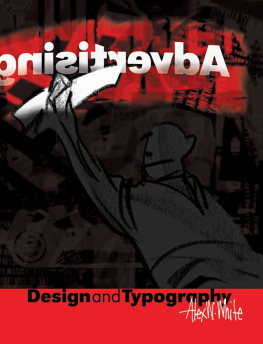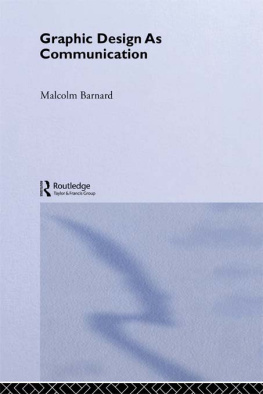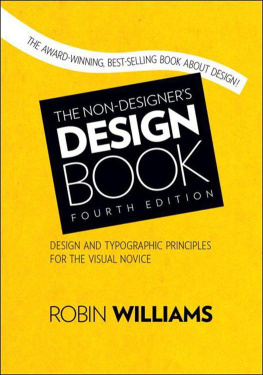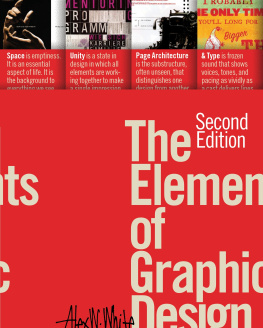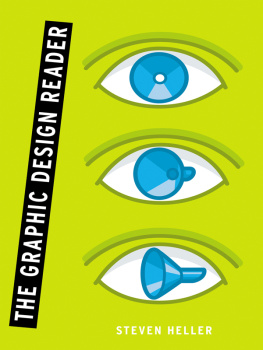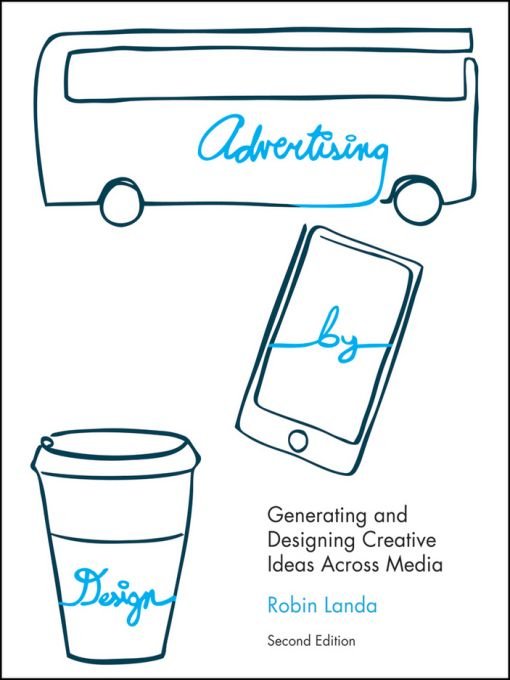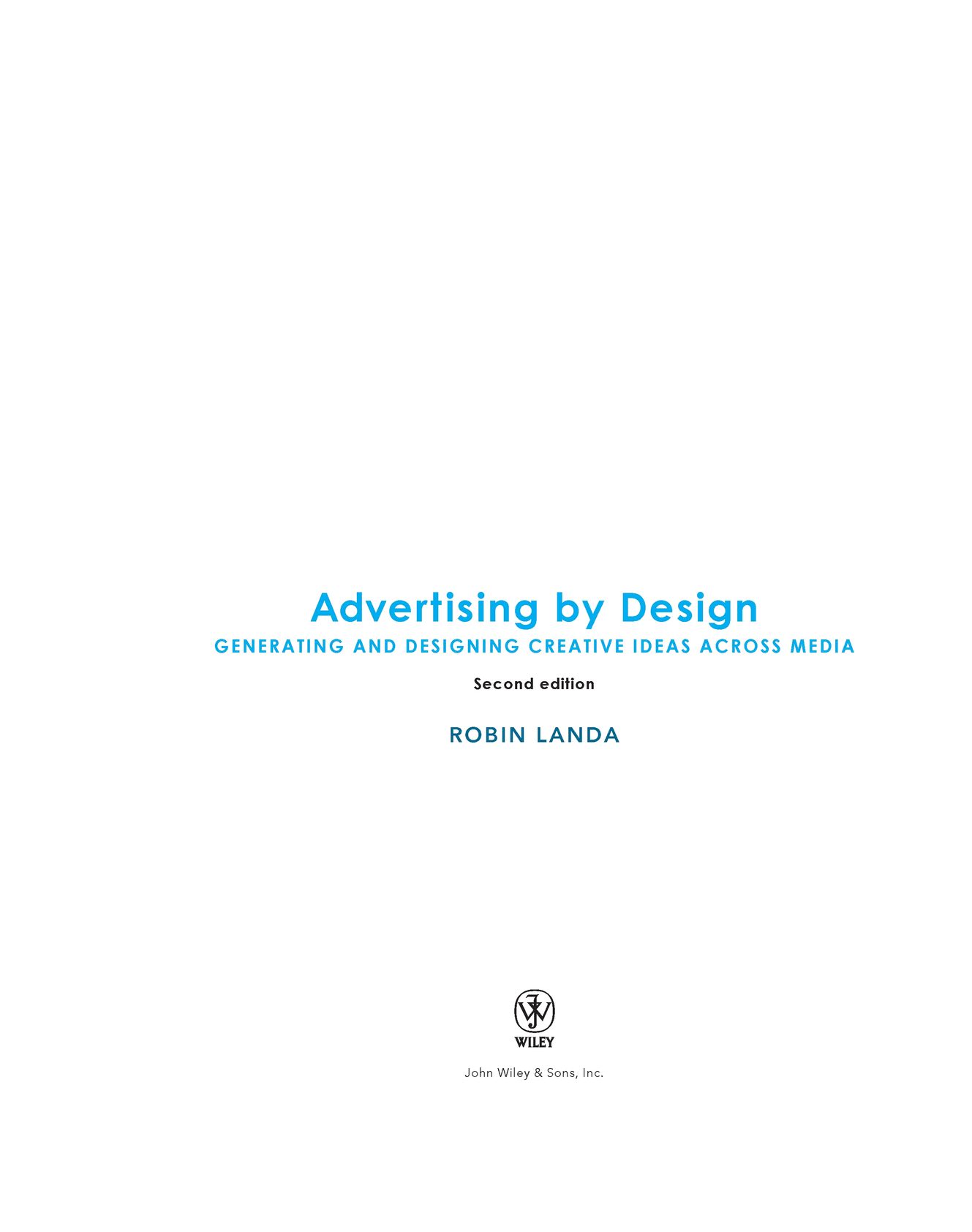Table of Contents
TO MY PRECIOUS CREATIVITY DIVA, MY DAUGHTER, HAYLEY, AND TO MY STUDENTS AND FORMER STUDENTS.
LET US BE GRATEFUL TO PEOPLE WHO MAKE US HAPPY; THEY ARE THE CHARMING GARDENERS WHO MAKE OUR SOULS BLOSSOM.MARCEL PROUST
PREFACE
NEW TO THIS EDITION
The second edition of Advertising by Design has been greatly expanded, reflecting the suggestions of professors from esteemed institutions and ad agency creative directors. It remains the most comprehensive text on creative concept generation and designing for advertising, and it includes a number of features that make it an effective tool for instructors, students, or any reader interested in the creative side of advertising. In Advertising by Design, the approach to generating and designing creative integrated-media advertising for brands, organizations, and causes encompasses brand building through engagement, community building, added value, and entertainment.
This new edition of
Advertising by Design> Teaches the fundamental conceptual development, design, and copywriting abilities that students need to start creating ads
> Guides students to think clearly and conceptually
> Stimulates creative thinking through brainstorming tools and exercises
> Integrates conceptualization, visualization, and composition
> Includes substantive content on visualizing and composing ideas, including information on designing with typography
> Utilizes illustrations to inspire critical and creative thinking
> Incorporates diagrams to help explain design thinking
It offers as well the following essentials and enhancements:
> A thorough guide to conceptualizing and designing for print, interactive applications, branded utilities, television, social media, branded content and entertainment, branded alliances, outdoor and digital out-of-home media, mobile media, and motion, ambient, and unconventional media
> Tools to stimulate creative thinking, tools for brainstorming, and creativity exercises to prompt and support conceptualization
> Methods for idea generation
> An extensive chapter on visualization, including approaches, methods, and media for visualization of design ideas and understanding images
> A comprehensive chapter on compositioncovering a wide range of theories and points of view as well as media (composing for print, screen, and motion)
> In-depth information covering the five steps of the design process
> Integrated media ad campaigns
> Storytelling in advertising
> Creative approachesthe most comprehensive examination of model frameworks found in any one volume
> New interviews
> Showcases
> Case studies
> A glossary
> Numerous exercises
> New illustrations and examples
FEATURES
> Clear explanation of designing for major advertising applications
> Comprehensive examination of visualization and composition theories and methodologies
> Explanation of media
> Designing with type
> Writing headlines and taglines
> Creative approaches
> Historical framework that places discussed theories into a broader context
> Bulleted lists and sidebars to assist comprehension
> Exercises to jump-start critical and creative thinking as well as visualization
> State-of-the-profession overview of advertising
> Essays by designers, creative directors, and writers
> Showcases
> Timeless examples and illustrations
> Exercises, projects (for classroom or personal use and portfolio building), and other online supplements
From the Field
The most highly regarded design professionals today provide insights and examples in stimulating features,
for example:> Case Studies:Youth Reckless Driving Prevention (Chapter 1); Behind the Scenes: MoMA / Tim Burton Exhibition (Chapter 2); Digital, Swaggerize Me (Chapter 13); and Storyboard, Sony Ericsson Big Screen for mobile devices (Chapter 14)
> Interviews:Rosie Arnold, deputy executive creative director, BBH (Chapter 3); and Kevin Roberts, CEO Worldwide of Saatchi & Saatchi (Chapter 4)
> Showcase:Posters by Robynne Raye of Modern Dog Design Co. (Chapter 8)
Resources for Instructors
Online instructor materials include:
> 11-week syllabi
> 15-week syllabi
> Additional exercises and projects
> Additional interviews and creative showcases
> Powerpoints
> Grading rubric
> Web site links
> Test questions for every chapter
ORGANIZATION
A historical perspective is provided online; an instructor can start there or use the history as a reference. Part I provides a substantial foundation of essential information, including an introduction examining the advertising profession; the steps in the design process and the creative brief; and comprehensive coverage of thinking creatively. Part II focuses on formulating advertising ideas, writing, and designing: understanding the brand idea; idea development; copywriting; creative approaches; typography and visualization; and composition; and storytelling.
Part III is an in-depth examination of designing for print; motion, broadcast, and broadband; integrated campaigns; storytelling; Web sites and branded utilities; mobile devices; social media; and unconventional marketing. The chapters are easily used in any order that is appropriate for the reader or that best suits the educator. Each chapter provides substantial background information about how the advertising application is used and how to design for that medium. Also included are sidebars with suggestions, tips, and important design considerations, as well as informative features such as essays, case studies, and showcases of outstanding creative professionals. Some chapters are much longer than others because of the role they play in most curricula.
This new edition covers a vast amount of information, therefore:
> Instructors have plenty of content from which to choose;
> This book can be used in several courses, carrying over from semester to semester;
> This book is a reference and resource.
At the end of the book, there is a glossary to help with terminology, a selected bibliography to encourage further reading, and an index.
Additional material and resources (including many exercises and projects) are available online.
The Illustrations and Quotations
Ads are created daily, and there are many places to see contemporary and historical advertising solutionsfrom periodicals to blogs to online galleries. In selecting illustrations for this book, I tried to choose classic examples of creative conceptual thinking and thoughtful design that would endure. Also, I chose the illustrations to represent different approaches, schools of thought, and design sensibilities.



